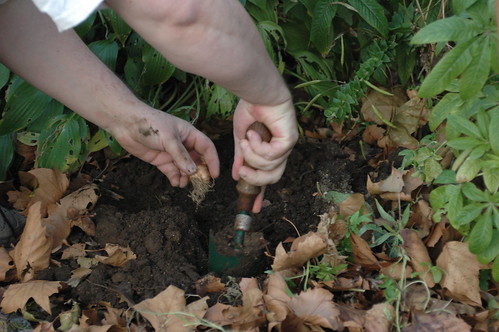Fraxinus americana, White Ash, one of the street trees that will be on the tour.
On Saturday, October 24, Sustainable Flatbush will host its first Fall Street Tree Walking Tour. And I’m looking forward to once again be one of the guides for the tour.
FOR IMMEDIATE RELEASE
Brooklyn, NY October 16, 2009
SUSTAINABLE FLATBUSH FALL 2009 STREET TREE WALKING TOUR
Saturday, October 24, 2009—Rain or Shine
Based on the success of the annual walking tour events in celebration of Arbor Day and spring in bloom, Sustainable Flatbush is now introducing the inaugural Fall Street Tree Walking Tour. The tour guides will be Tracey Hohman, professional gardener, and Chris Kreussling, aka Flatbush Gardener, both neighborhood residents.
Sustainable Flatbush Street Tree Walking Tour, Arbor Day 2009. That’s me in the middle, next to the tree. Photo by Keka
Throughout the tour, your street tree guide will:
- identify trees and their characteristics
- share interesting facts
- explore local tree history
- discuss the many ways street trees benefit the environment
- explain how to obtain and care for street trees
- and much more!
This free event is a perfect opportunity to visit Victorian Flatbush in the heart of Brooklyn and experience the neighborhood’s breathtaking street trees—including some that are more than 100 years old!
Location:
Tours start at Sacred Vibes Apothecary, 376 Argyle Road, just south of Cortelyou Road
View Sustainable Flatbush Fall 2009 Street Tree Walking Tour in a larger map
Directions:
- Take the Q train to Cortelyou Road Station and walk west after exiting the station toward Argyle Road.
- Buses that stop on or near Cortelyou Road include the B23, B103, B68, and BM1,2,3,4 and x29 express busess.
- As a reminder, check the MTA website for schedule and service advisories before you head out.
Time:
Tours depart at 11:00 AM and 12:00 NOON.
Tours take about 2 hours to complete and are 1 mile in length.
This is a rain or shine event – please dress for the weather!
For more information, please contact Sustainable Flatbush
Foliage Report
The New York State Fall Foliage Report for the week of October 14-20 is reporting that NYC is “just changing.”
I can confirm that, with Dogwoods, White Ash and now Locust trees all in full color. Sweet Gum and Oaks are starting to turn. If cooler weather persists through the week, peak colors will probably arrive just in time for Halloween on the 31st. Still, there should be lots of color for us to enjoy on the 24th.
A Japanese Maple on Marlborough Rad in Prospect Park South, part of the tour, November 2007
[bit.ly]
Related Content
Fall Approaches, 2009-09-26
Links
Fall Foliage Walking Tour October 24th!, Sustainable Flatbush











































